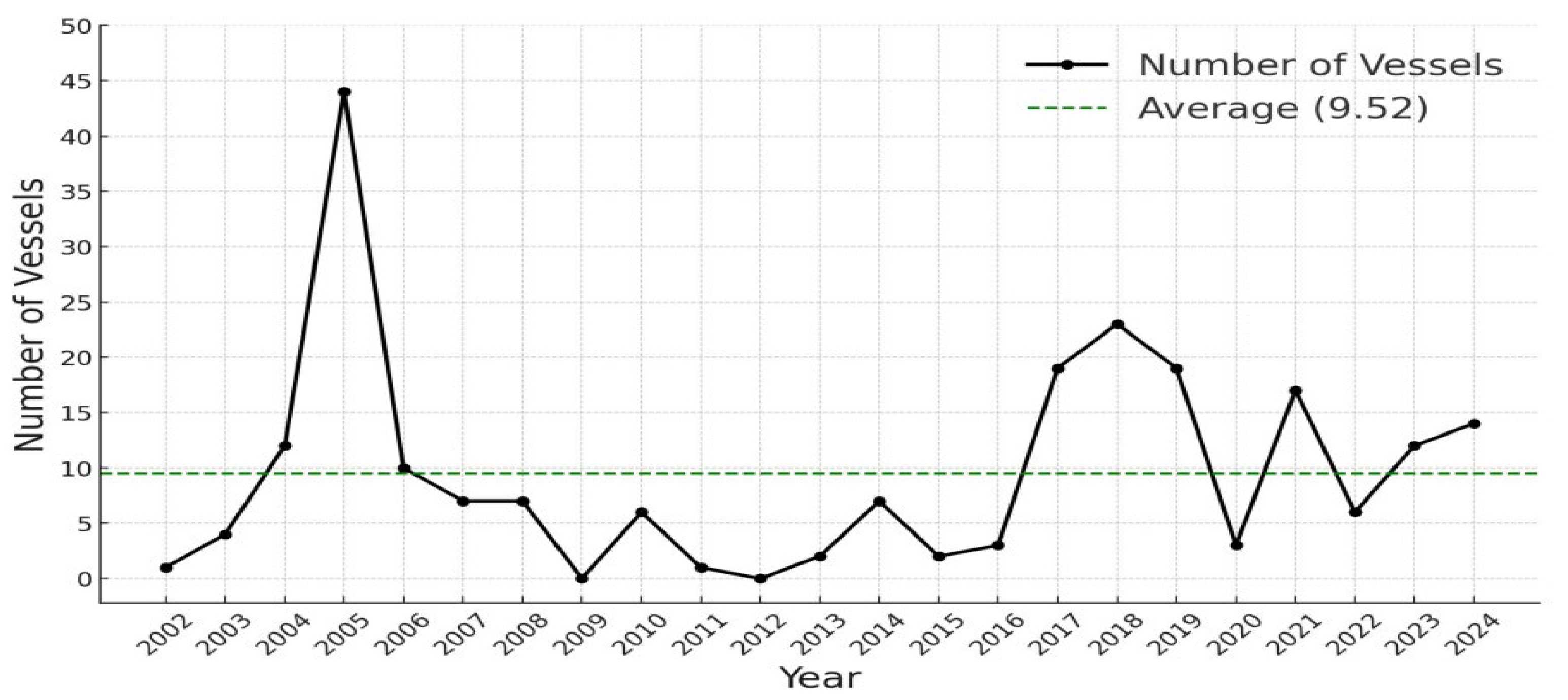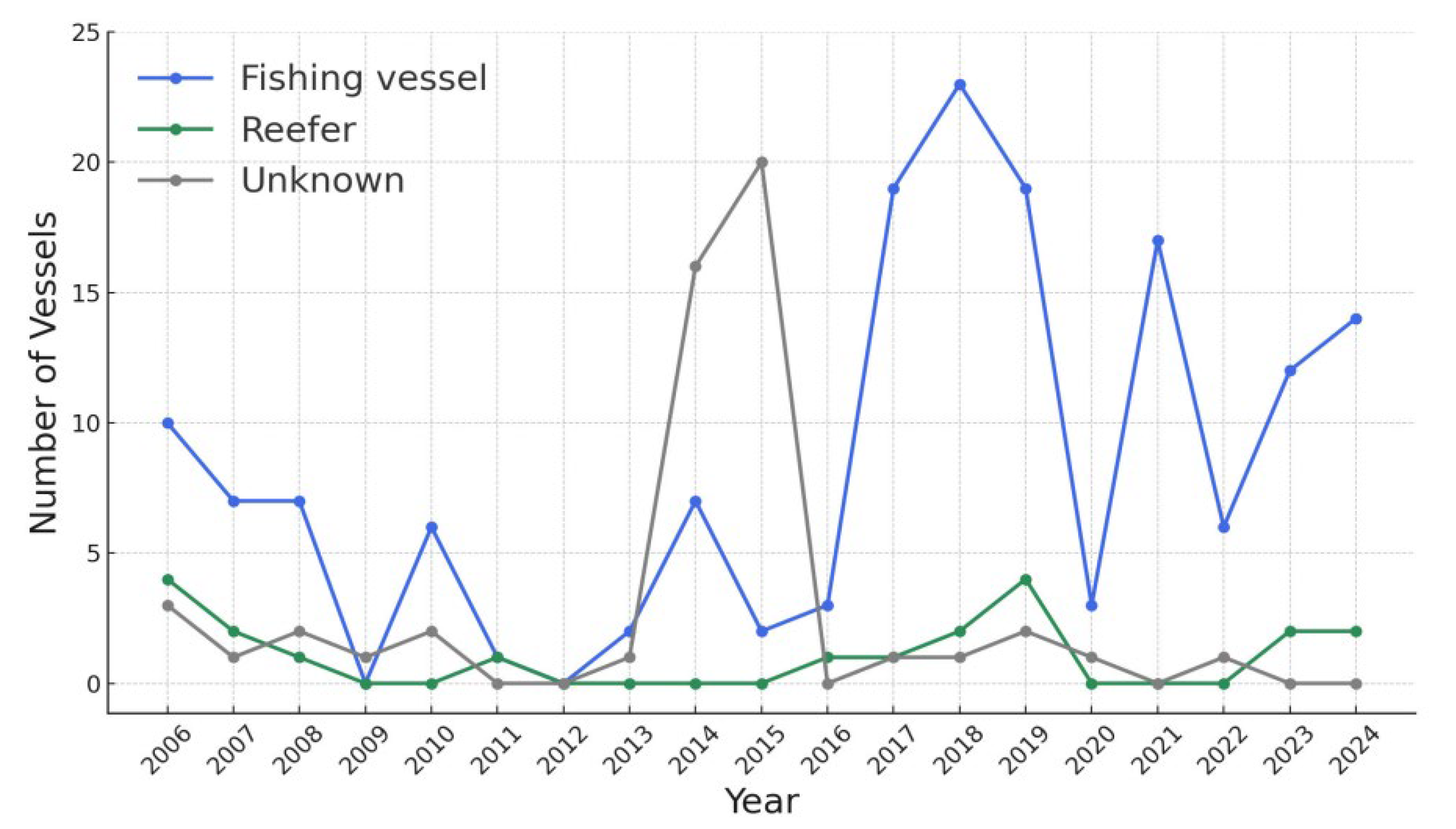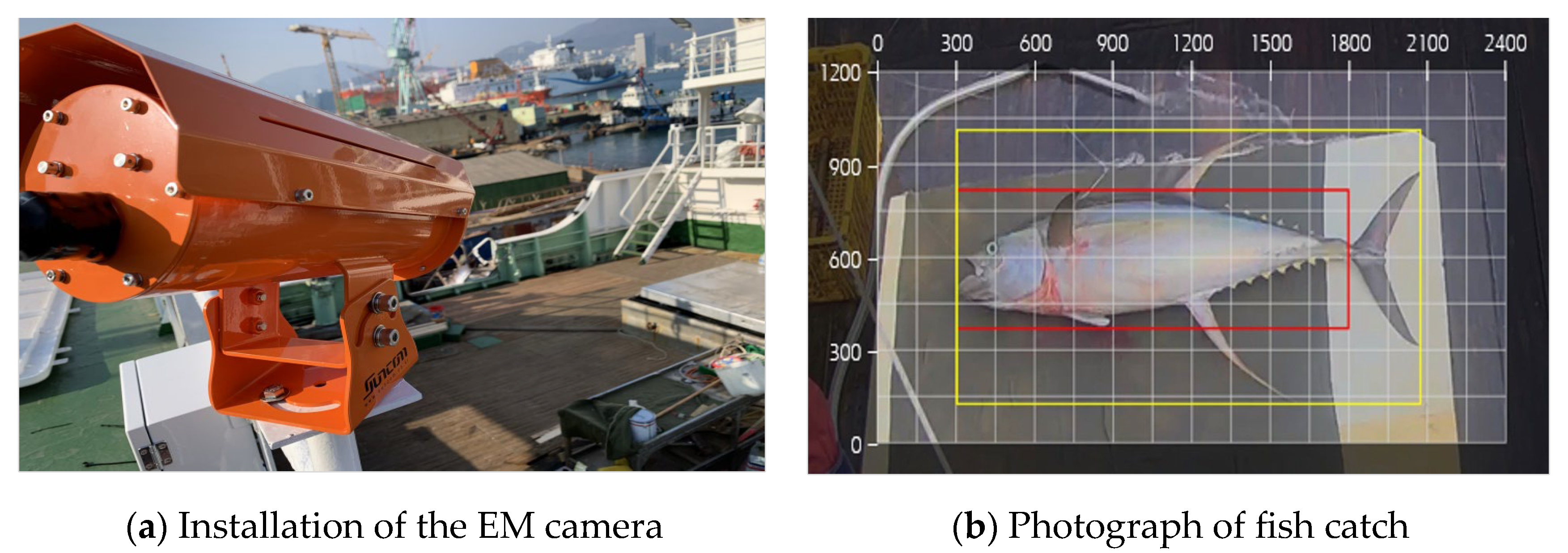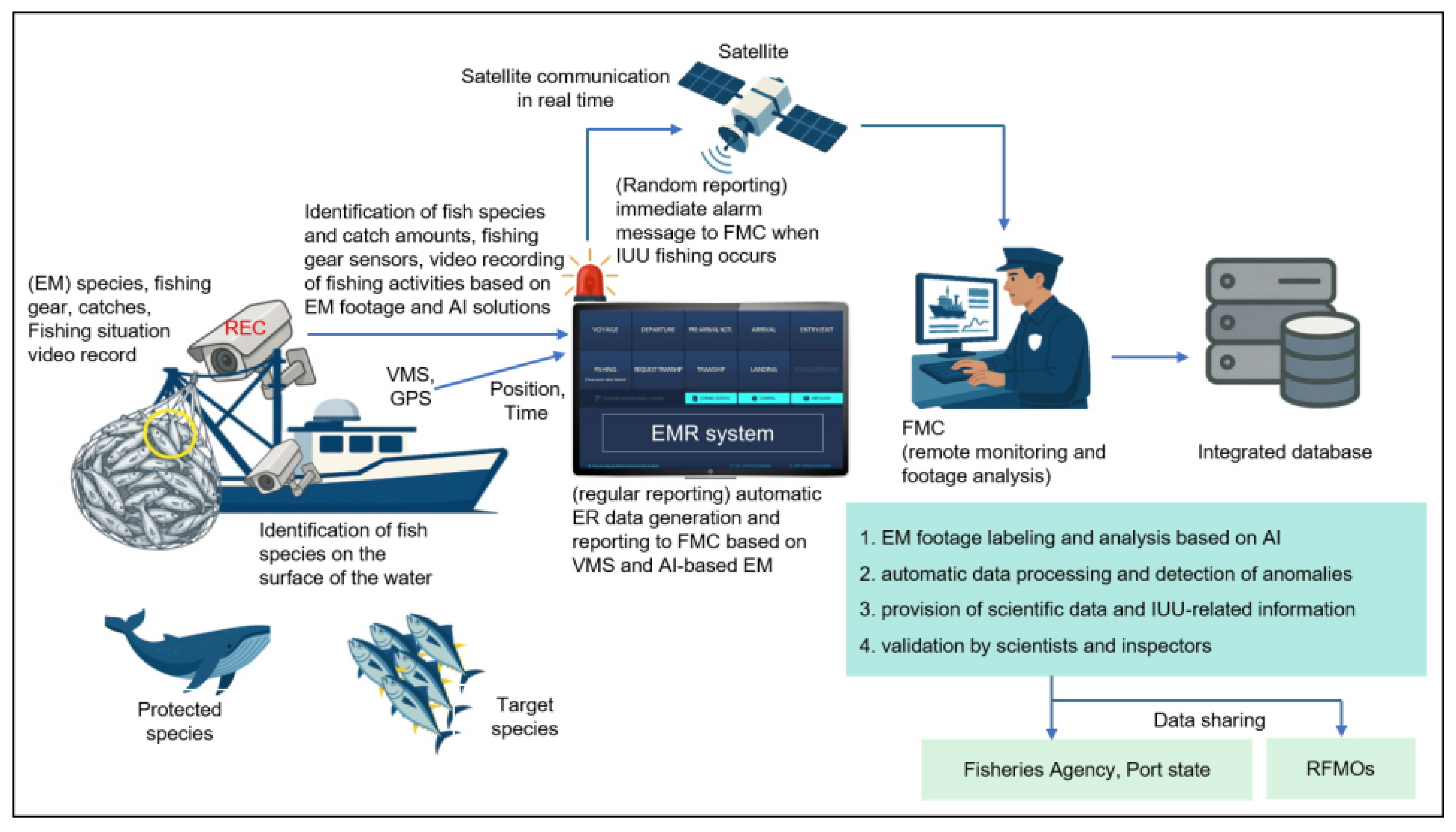Conceptual Design of the Intelligent Electronic Monitoring and Reporting Model for Combating Global Illegal, Unreported, and Unregulated Fishing
Abstract
1. Introduction
2. Literature Review and Methodology
2.1. Literature Review
2.2. Methodology
3. IUU and EMS/ERS Status
3.1. Current Status of IUU
3.1.1. Annual Status and Trends of IUU Vessels
3.1.2. Status and Trends of IUU Vessels by Vessel Type
3.1.3. Status and Trends of IUU Vessels by Fishing Gear Type
3.2. Current Status and Problems of EMS and ERS
3.2.1. Current Status of EMS and Problems of the Traditional System
3.2.2. Current Status of ERS and Problems of the Traditional System
4. Proposed I-EMR Model and Framework
4.1. I-EMR Model and Framework
4.2. Measures to Develop Effective I-EMR System
4.3. Discussion and Limitations
5. Conclusions
Author Contributions
Funding
Institutional Review Board Statement
Data Availability Statement
Conflicts of Interest
References
- Christensen, J. Illegal, Unreported and Unregulated Fishing in Historical Perspective. In Perspectives on Oceans Past; Springer: Berlin/Heidelberg, Germany, 2016; pp. 133–153. [Google Scholar]
- Sumaila, U.R.; Zeller, D.; Hood, L.; Palomares, M.D.; Li, Y.; Pauly, D. Illicit trade in marine fish catch and its effects on ecosystems and people worldwide. Sci. Adv. 2020, 6, eaaz3801. [Google Scholar] [CrossRef] [PubMed]
- Petrossian, G.A. Preventing illegal, unreported and unregulated (IUU) fishing: A situational approach. Biol. Conserv. 2015, 189, 39–48. [Google Scholar] [CrossRef]
- Trygg Mat Tracking (TMT). Available online: https://www.tm-tracking.org (accessed on 4 April 2025).
- Garcia, S.G.; Barclay, K.; Nicholls, R. Can anti-illegal, unreported, and unregulated (IUU) fishing trade measures spread internationally? Case study of Australia. Ocean. Coast. Manag. 2021, 202, 105494. [Google Scholar] [CrossRef]
- Park, S.-W.; Go, S.-Y. Alignment of RFMO’s Transparency Requirements ad Korean Fishery Laws to Prevent IUUs. Environ. Law Policy 2021, 27, 161–207. [Google Scholar] [CrossRef]
- Worm, B.; Barbier, E.B.; Beaumont, N.; Duffy, J.E.; Folke, C.; Halpern, B.S.; Jackson, J.B.C.; Lotze, H.K.; Micheli, F.; Palumbi, S.R.; et al. Impacts of biodiversity loss on ocean ecosystem services. Science 2006, 314, 787–790. [Google Scholar] [CrossRef] [PubMed]
- Van Helmond, A.T.M.; Mortensen, L.O.; Plet-Hansen, K.S.; Ulrich, C.; Needle, C.L.; Oesterwind, D.; Kindt-Larsen, L.; Catchpole, T.; Mangi, S.; Zimmermann, C.; et al. Electronic monitoring in fisheries: Lessons from global experiences and future opportunities. Fish Fish. 2019, 21, 162–189. [Google Scholar] [CrossRef]
- Ulrich, R.; Schröter, H.; Leuthold, H.; Birngruber, T. Automatic and controlled stimulus processing in conflict tasks: Superimposed diffusion processes and delta functions. Cogn. Psychol. 2015, 78, 148–174. [Google Scholar] [CrossRef] [PubMed]
- An, J.; Oh, S.Y.; Jung, M.H. A Study on the Economic Impacts of the Introduction of Electronic Monitoring of Distant-water. J. Marit. Bus. 2021, 50, 93–116. [Google Scholar]
- Cromwell, J.; Turkson, C.; Dora, M.; Yamoah, F.A. Digital technologies for traceability and transparency in the global fish supply chains: A systematic review and future directions. Mar. Policy 2025, 178, 106700. [Google Scholar] [CrossRef]
- van Helmond, A.T.M.; Chen, C.; Poos, J.J. How effective is electronic monitoring in mixed bottom-trawl fisheries? ICES J. Mar. Sci. 2015, 72, 1192–1200. [Google Scholar] [CrossRef]
- Colson Leaning, D.; McGonigal, H.; Seeley, M.; Jud, S. Enhancing Federal Cost Savings: Electronic Monitoring and Reporting in U.S. Fisheries; Environmental Defense Fund (EDF): New York, NY, USA, 2024. [Google Scholar]
- Brown, C.J.; Desbiens, A.; Campbell, M.D.; Game, E.T.; Gilman, E.; Hamilton, R.; Heberer, C.; Itano, D.; Pollock, K. Electronic monitoring for improved accountability in western Pacific tuna longline fisheries. Mar. Policy 2021, 132, 104664. [Google Scholar] [CrossRef]
- Elsira, I.; Tilley, A.; Samy-Kamal, M.; Aly, W. Digital transformation of Egyptian marine fisheries: A pathway to sustainable fisheries management. Mar. Policy 2025, 179, 106766. [Google Scholar] [CrossRef]
- Goldsmith, W.M.; Scheld, A.M.; McGuire, C.; Lobue, C. Improving electronic reporting rates in the U.S. recreational fishery for Atlantic Bluefin Tuna. N. Am. J. Fish. Manag. 2023, 43, 893–907. [Google Scholar] [CrossRef]
- Midway, S.R.; Adriance, J.; Banks, P.; Haukebo, S.; Caffey, R. Electronic Self-reporting: Angler Attitudes and Behaviors in the Recreational Red Snapper Fishery. N. Am. J. Fish. Manag. 2020, 40, 1119–1132. [Google Scholar] [CrossRef]
- Li, S. Combating IUU fishing: An examination of interaction between China and regional fisheries management organizations. Front. Mar. Sci. 2025, 12, 1601534. [Google Scholar] [CrossRef]
- Hutniczak, B. Coordination between RFNOs on mutual recognition of IUU vessel lists. Mar. Policy 2019, 107, 103596. [Google Scholar] [CrossRef]
- NOAA. Improving International Fisheries Management 2019 Report to Congress. Available online: https://media.fisheries.noaa.gov/dam-migration/improvingintlfisheriesmgmt_2019_report_final.pdf (accessed on 24 August 2025).
- FAO. Global Record—News and Events. Available online: https://www.fao.org/global-record/news-events/detail/fr/c/1734773/?utm (accessed on 2 June 2025).
- Needle, C.L.; Dinsdale, R.; Buch, T.B.; Catarino, R.M.D.; Drewery, J.; Butler, N. Scottish science applications of Remote Electronic Monitoring. ICES J. Mar. Sci. 2015, 72, 1214–1229. [Google Scholar] [CrossRef]
- Shen, H.; Song, L. Bridging the Gap between Electronic Monitoring Policy and Practice: From the Perspective of Chinese Tuna Longliners. Fishes 2024, 9, 384. [Google Scholar] [CrossRef]
- Pew Reseach Center. Japan Poised to Lead on Fisheries Oversight in Pacific. Available online: https://www.pewtrusts.org/en/research-and-analysis/articles/2023/05/24/japan-poised-to-lead-on-fisheries-oversight-in-pacific (accessed on 16 July 2025).
- Western and Central Pacific Fisheries Commission (WCPFC). Development of interim Electronic Monitoring (EM) standards for the WCPFC. In Proceedings of the Scientific Committee Twentieth Regular Session, Manila, Philippines, 14–21 August 2024. [Google Scholar]
- Inter-American Tropical Tuna Commission (IATTC). Staff recommendations EMS standards. In Proceedings of the Workshop on Implementation of an EMS 1st Meeting, Online, 22–23 April 2021. [Google Scholar]
- Inter-American Tropical Tuna Commission (IATTC). Interim Minimum standards for the use of EMS in IATTC fisheries. In Proceedings of the 102nd Meeting, Panama City, Panama, 2–6 September 2024. [Google Scholar]
- Wikipedia. Electronic Reporting System. Available online: https://en.wikipedia.org/wiki/Electronic_Reporting_System (accessed on 16 July 2025).
- European Commission. Fisheries: New Report Shows Progress, but Also Shortcomings in the Implementation of the Control Regulation. Available online: https://oceans-and-fisheries.ec.europa.eu/news/fisheries-new-report-shows-progress-also-shortcomings-implementation-control-regulation-2021-06-22_en (accessed on 16 July 2025).
- NOAA Fisheries. Electronic Reporting. Available online: https://www.fisheries.noaa.gov/national/fisheries-observers/electronic-reporting (accessed on 16 July 2025).
- McElderry, H. At-sea observing using video-based electronic monitoring. In Proceedings of the ICES Annual Science Conference, Maastricht, The Netherlands, 19–23 September 2006; p. 25. [Google Scholar]
- Course, G.P.; Pierre, J.P.; Howell, B.K. What’s in the Net? Using Camera Technology to Monitor, and Support Mitigation of, Wildlife Bycatch in Fisheries; WWF: York, UK, 2020. [Google Scholar]
- MRAG Ltd. Review of Good Practice in Monitoring, Control and Surveillance, and Observer Programmes; Marine Stewardship Council: London, UK, 2019. [Google Scholar]
- Orofino, S.; McDonald, G.; Mayorga, J.; Costello, C.; Bradley, D. Opportunities and challenges for improving fisheries management through greater transparency in vessel tracking. ICES J. Mar. Sci. 2023, 80, 675–689. [Google Scholar] [CrossRef]
- NOAA Fisheries. Electronic Monitoring. Available online: https://www.fisheries.noaa.gov/national/fisheries-observers/electronic-monitoring (accessed on 24 July 2025).







| Article Title | Method of Study | Key Conclusions and Implications |
|---|---|---|
| “EM in fisheries: Lessons from global experiences and future opportunities” [8] | Analysis of global EM application cases | EM, as a monitoring tool, demonstrates several strengths that outweigh its weaknesses. It also holds promise as a future tool when integrated with existing data collection programs. |
| “EM for improved accountability in Western Pacific tuna longline fisheries” [14] | Evaluation of EM’s effectiveness in Pacific longline fisheries | EM data recorded greater species diversity than logbook entries. Its further expansion could enhance the management of both target and bycatch species. |
| “Digital transformation of Egyptian marine fisheries: A pathway to sustainable fisheries management” [15] | Assessment of MCS technologies in Egypt’s Mediterranean fisheries | The successful adoption of advanced monitoring systems requires a phased approach, beginning with targeted pilot programs in priority fisheries and followed by incremental scaling supported by technical capacity building. |
| “Improving ER Rates in the U.S. Recreational Fishery for Atlantic Bluefin Tuna” [16] | Survey on ER awareness among recreational anglers | The study confirmed low reporting rates and proposed measures to increase engagement among fishery participants. |
| “Electronic Self-reporting: Angler Attitudes and Behaviors in the Recreational Red Snapper Fishery” [17] | Behavioral and attitudinal analysis of self-reporting | User acceptance was found to be crucial, with reliability and convenience significantly influencing participation rates. |
| Country | Target Fisheries | Monitoring Scope | Applied Technologies and Features |
|---|---|---|---|
| Australia | Trawl, longline, handline, trap, set nets | Protected species bycatch, gear deployment, catch documentation | High-resolution cameras, real-time monitoring, full coverage |
| Canada | Trap, longline, groundfish trawl | Catch monitoring, gear use | Cameras, sensors, GPS, continuous EM system operation |
| EU | Bottom trawl, set net, longline, purse seine | Full catch documentation, protected species, compliance behavior | AI trials for species identification, basket-view cameras, limited 4G transmission |
| New Zealand | Trawl, set nets | Bycatch handling, gear use, catch quantity | Onboard video monitoring, precision video recording, in-trawl cameras |
| USA | Trawl, longline, trap | Catch, effort, protected species bycatch, compliance | R&D on automated video analysis, random video sampling |
| Country | Target Fisheries | Monitoring Scope | Applied Technologies and Features |
|---|---|---|---|
| China [23] | Distant-water fisheries | Compliance, catch documentation, IUU prevention | EMS with cameras and GPS, cloud-based data storage, AI-assisted video review |
| Japan [24] | Tuna longline, coastal, and distant-water fisheries | Catch, bycatch, CPUE | EM complements human observers; emphasis on transparency |
| Republic of Korea (Internal data) | Distant-water tuna longline | Catch data collection, fishing activity monitoring, preparation for international compliance | AI-based video recognition and catch estimation; EMS development ongoing (2025–2028 R&D project) |
| Items | WCPFC | IATTC |
|---|---|---|
| Start of discussion | 2014 | 2019 |
| Organizational structure for discussions | Operation of EM/ER Working Group (W/G), etc. | Operation of Scientific Advisory Committee and Working Group (W/G), etc. |
| CMM/ Standard draft | Drafting of EM CMM and minimum standards [25]; adopting the interim EM technical standards (2024) | Drafting of EM standard [26] and roadmap (2021–2025); adopting a resolution on the interim EM minimum standards [27] (2024) |
| Objects of application | Western and Central Pacific longline and purse seine fisheries | Eastern Pacific tuna longline and purse seine fisheries |
| Main content | The main content includes the operation of the EM/ER Working Group, the establishment of minimum standards for the EM program, and the definition of the EM system together with data ownership regulations | The roadmap for EM minimum standards [26] (2021–2025), the pilot project for longline and purse seine, and the four key components of the EM standard: definitions, institutional structure, management guidelines, and technical standards |
| Implementation roadmap | Discussions with member countries following EMP standard [25] establishment; exploring EM applications in 2025 | Review the interim standards [27], aiming for full implementation in 2027 |
| Country | Key Features |
|---|---|
| EU [29] | Expanded the ER of catch data and implemented automated cross-validation of fishery data |
| Republic of Korea (Internal data) | Pilot EM/ER integration project on distant-water fishing vessels; use of digital logbooks and a cross-checking system |
| United States [30] | Digital logbooks for commercial and recreational fisheries; integration with observer programs; near-real time data submission |
| Process Stage | Function | EM | ER |
|---|---|---|---|
| Data Collection | Video recording during fishing (standardized resolution, GPS watermark) | ● | - |
| Capture electronic logbook entries (permits, reports, fishing info) | - | ● | |
| Collect scientific data | ● | ● | |
| Data Analysis | Gear recognition | ● | - |
| Species classification | ● | - | |
| IUU fishing recognition | ● | - | |
| Fishing activity determination (based on EM video or ER logbook) | ● | ● | |
| Machine Learning | Data preprocessing and labeling | ● | ● |
| Data augmentation (diversification of training data) | ● | ● | |
| AI model creation (e.g., YOLO Vx) | ● | ||
| Integration and Communication | Merge EM and ER data streams; cross-check with VMS | ● | ● |
| Real-time data/video transmission and compression | ● | ||
| Bidirectional information exchange | ● | ● | |
| Information Management | Secure data storage and encryption | ● | ● |
| Centralized integrated database | ● | ● | |
| Access control and user permission management | ● | ● | |
| Object recognition and analysis servers | ● | ||
| Web/streaming/search server | ● |
Disclaimer/Publisher’s Note: The statements, opinions and data contained in all publications are solely those of the individual author(s) and contributor(s) and not of MDPI and/or the editor(s). MDPI and/or the editor(s) disclaim responsibility for any injury to people or property resulting from any ideas, methods, instructions or products referred to in the content. |
© 2025 by the authors. Licensee MDPI, Basel, Switzerland. This article is an open access article distributed under the terms and conditions of the Creative Commons Attribution (CC BY) license (https://creativecommons.org/licenses/by/4.0/).
Share and Cite
Lim, S.-s.; Jung, B.-k. Conceptual Design of the Intelligent Electronic Monitoring and Reporting Model for Combating Global Illegal, Unreported, and Unregulated Fishing. Fishes 2025, 10, 435. https://doi.org/10.3390/fishes10090435
Lim S-s, Jung B-k. Conceptual Design of the Intelligent Electronic Monitoring and Reporting Model for Combating Global Illegal, Unreported, and Unregulated Fishing. Fishes. 2025; 10(9):435. https://doi.org/10.3390/fishes10090435
Chicago/Turabian StyleLim, Sung-su, and Bong-kyu Jung. 2025. "Conceptual Design of the Intelligent Electronic Monitoring and Reporting Model for Combating Global Illegal, Unreported, and Unregulated Fishing" Fishes 10, no. 9: 435. https://doi.org/10.3390/fishes10090435
APA StyleLim, S.-s., & Jung, B.-k. (2025). Conceptual Design of the Intelligent Electronic Monitoring and Reporting Model for Combating Global Illegal, Unreported, and Unregulated Fishing. Fishes, 10(9), 435. https://doi.org/10.3390/fishes10090435






